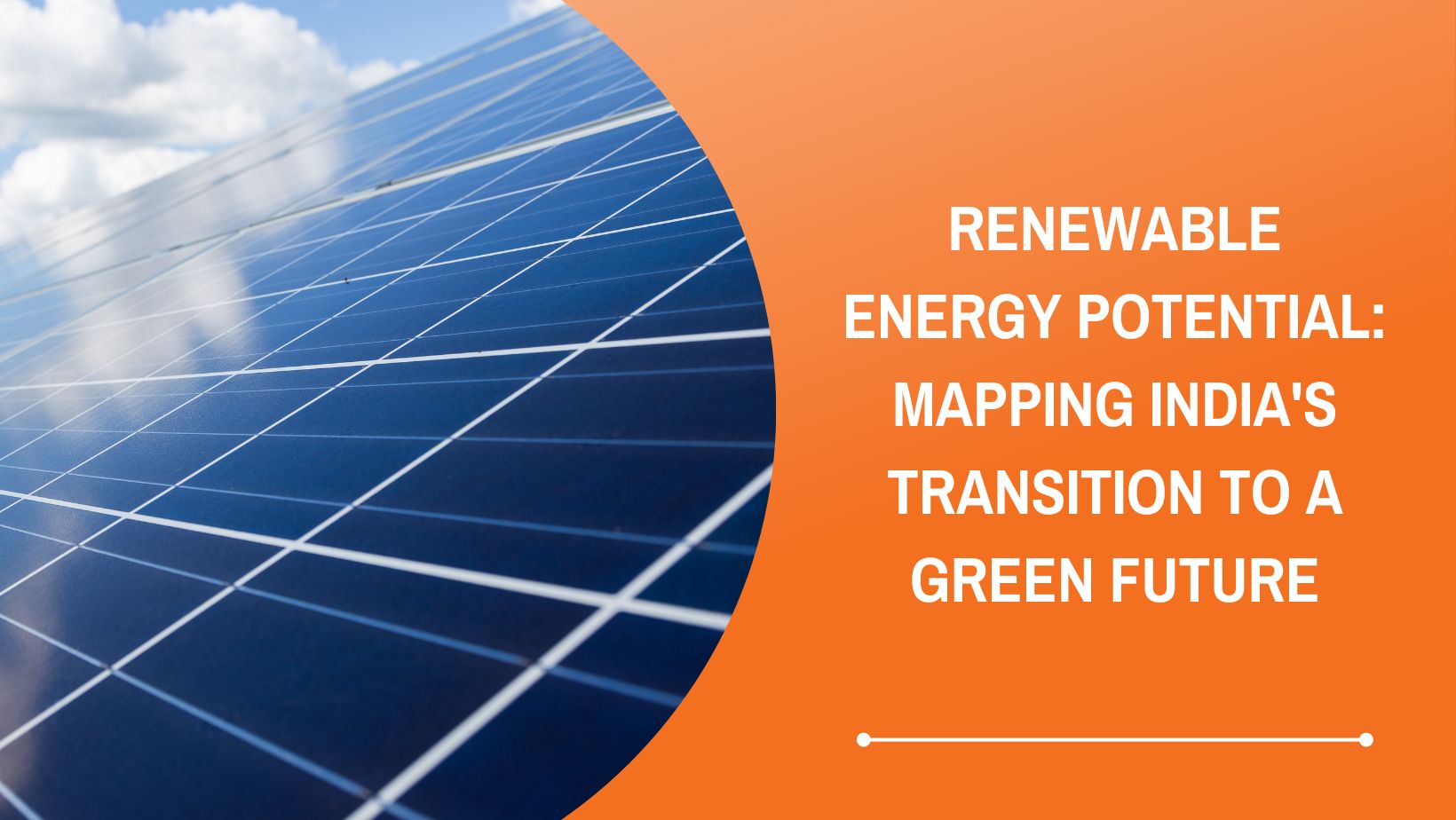Renewable Energy Potential: Mapping India's Transition to a Green Future
India stands at a crucial juncture in its quest for sustainable development, marked by a significant shift towards renewable energy sources. With the pressing need to mitigate climate change and reduce dependence on fossil fuels, the country is increasingly turning to solar energy and other renewables to power its future. This transition is not merely about embracing cleaner sources of energy; it represents a fundamental restructuring of India's energy landscape, with far-reaching implications for its economy, environment, and society.
Embracing Solar Power:
Solar energy has emerged as a cornerstone of India's renewable energy strategy. Blessed with abundant sunlight throughout the year, India possesses immense solar energy potential, making it an ideal candidate for large-scale solar power generation. The government's ambitious targets, such as achieving 100 GW of solar capacity by 2022 and 450 GW by 2030, underscore its commitment to harnessing this abundant resource.
One of the most notable successes in India's solar journey has been the dramatic reduction in solar tariffs. Through competitive bidding processes and technological advancements, the cost of solar power has plummeted, making it increasingly competitive with conventional sources of energy. This cost competitiveness has not only accelerated the deployment of solar projects but has also made solar energy accessible to a wider range of consumers, including industries, commercial establishments, and households.
Beyond Solar: Diversifying the Renewable Portfolio:
While solar energy dominates discussions around India's renewable energy transition, other sources such as wind, hydro, biomass, and geothermal also play crucial roles. Wind energy, in particular, has witnessed significant growth, with India emerging as one of the world's top wind energy producers. Similarly, the untapped potential of hydroelectric power, particularly in regions like the Himalayas, presents opportunities for further expansion.
Moreover, advancements in technology and innovation are opening up new frontiers in renewable energy. From offshore wind farms to floating solar installations and innovations in energy storage, these developments are enriching India's renewable energy portfolio and enhancing its resilience against variability in weather conditions.
Policy Support and Regulatory Framework:
The success of India's energy transition hinges upon a conducive policy environment and robust regulatory frameworks. The government's flagship initiatives, such as the National Solar Mission, the Green Energy Corridor Project, and various state-level policies, provide the necessary impetus for renewable energy deployment. Furthermore, measures such as renewable purchase obligations, net metering, and fiscal incentives are incentivizing investments in clean energy projects.
However, challenges persist, including land acquisition issues, grid integration constraints, and financing hurdles. Addressing these challenges requires a coordinated effort from policymakers, industry stakeholders, and civil society to streamline processes, enhance grid infrastructure, and mobilize investments.
Socioeconomic Impacts and Opportunities:
India's transition to renewable energy is not only about reducing carbon emissions; it also holds immense socioeconomic potential. The renewable energy sector is a significant driver of job creation, offering employment opportunities across the value chain, from manufacturing and installation to operations and maintenance. Moreover, decentralized renewable energy solutions have the potential to empower rural communities by providing access to clean, reliable, and affordable energy.
Furthermore, by reducing dependence on imported fossil fuels, India's renewable energy push enhances energy security and reduces the nation's vulnerability to global energy price fluctuations. This, in turn, strengthens India's economic resilience and fosters sustainable growth.
Conclusion:
India's journey towards a green future powered by renewable energy is both promising and challenging. While significant progress has been made, much work lies ahead to realize the full potential of renewables and achieve the nation's energy transition goals. Collaboration among government, industry, academia, and civil society will be key to overcoming barriers, driving innovation, and accelerating the adoption of clean energy technologies. With steadfast commitment and collective action, India can pave the way for a sustainable, inclusive, and prosperous future powered by renewable energy.
For more information visit us @ https://www.azurepower.com/energy-transition
People
Circles
Posts
Unraveling the Depths of Architectural Design: A Challenge in Creativity and Precision
Welcome to Architecture Assignment Help.com, where we delve deep into the world of architectural design, pushing the boundaries of creativity and precision. Today, we present a blog that not only challenges your intellect but also fuels your passion for design, offering insights and solutions tailored to your architectural design Assignment Help needs.
Visit- https://www.architectureassignmenthelp.com/architectural-design-assignment-help/
Question:
Imagine you are tasked with designing a sustainable urban community from scratch. Your design should prioritize environmental conservation, community interaction, and aesthetic appeal. How would you approach this complex assignment, considering factors such as site selection, building materials, energy efficiency, and social integration?
Answer:
Designing a sustainable urban community is a multifaceted endeavor that requires a comprehensive understanding of environmental principles, social dynamics, and architectural innovation. Here’s how I would tackle this challenge:
Site Selection:
Begin by conducting a thorough analysis of potential sites, considering factors such as proximity to public transportation, access to amenities, and existing infrastructure.
Prioritize brownfield sites or underutilized urban areas to minimize environmental impact and promote revitalization.
Ensure the site offers ample green space for recreation, biodiversity, and stormwater management.
Building Materials:
Embrace sustainable building materials such as recycled steel, bamboo, and reclaimed wood to minimize embodied energy and reduce carbon footprint.
Implement passive design strategies to optimize natural ventilation, daylighting, and thermal comfort, thereby reducing reliance on mechanical systems.
Explore innovative materials like photovoltaic glass, aerogel insulation, and green roofs to enhance energy efficiency and aesthetic appeal.
Energy Efficiency:
Integrate renewable energy sources such as solar panels, wind turbines, and geothermal systems to generate onsite power and reduce reliance on fossil fuels.
Employ energy-efficient building systems, including high-performance insulation, LED lighting, and smart controls, to minimize energy consumption and operating costs.
Foster a culture of conservation through educational programs, energy monitoring tools, and incentivized behavior.
Social Integration:
Design mixed-use developments that combine residential, commercial, and recreational spaces to promote diversity, connectivity, and economic vitality.
Foster a sense of community through shared amenities such as community gardens, co-working spaces, and pedestrian-friendly streetscapes.
Prioritize universal design principles to ensure accessibility and inclusivity for people of all ages, abilities, and backgrounds.
Aesthetic Appeal:
Embrace biophilic design principles to reconnect residents with nature through elements such as green walls, water features, and natural materials.
Foster a sense of place and identity through site-specific artwork, cultural references, and architectural landmarks.
Balance innovation with context sensitivity to create a timeless and harmonious urban environment that resonates with both residents and visitors.
In conclusion, designing a sustainable urban community requires a holistic approach that balances environmental responsibility, social equity, and architectural excellence. By embracing innovation, collaboration, and empathy, architects can create spaces that not only enrich the built environment but also nurture the human spirit.
Salton Sea
Published June 30, 2022 6:44 PM
Salton Sea lithium suppliers say new CA tax bill is too high
By Angela Chen, Jesus Reyes
Geothermal Plant at Salton Sea
Wednesday night, California lawmakers approved the $3.8 billion state budget plan. Part of the budget includes a new tax on lithium being developed at the Salton Sea.
Lithium developer Controlled Thermal Resources said the tax is too high and will instead push people to buy lithium from China.
"CTR is confident that an independent study of the lithium market and tax mechanisms will make it abundantly clear to Governor Newsom that this additional tax, as it currently stands, will severely impact the development of ‘Lithium Valley’. ... Supporting a tax that ensures lithium imports from China are less expensive for auto manufacturers ... will devastate this promising Californian industry before it has begun."
- Statement from CTR
Local Assemblymember Eduardo Garcia's office who helped push the budget through supports the tax framework though saying:
"We needed to make certain that as this Lithium Valley industry emerges, our economically depressed and environmentally underserved community does not get left behind – this legislation accomplishes that. Years of discussion and input gathering with industry, the County of Imperial, residents, and other stakeholders led to the development of this tax framework."
- Assemblymember Garcia
CTR said they want an independent study on the lithium market to be done before they pay the taxes. The operating budget is heading to Governor Gavin Newsom's desk. He could sign it by the end of the week before lawmakers leave town on summer recess.
Earlier this month, CTR reached a 10-year agreement with automotive manufacturer Stellantis to supply its North American electric vehicle production. CTR will supply up to 25,000 metric tons per year of lithium hydroxide.
Last year, CTR struck a deal with General Motors to supply its future electric car batteries from lithium at the Salton Sea.
CTR isn't the only company in the mix looking to produce lithium in the Salton Sea.
Energy Source, which owns one of the 11 geothermal plants around the Salton Sea, also plans to produce lithium by April of 2024. Berkshire Hathaway, which owns the other 10 geothermal plants under the subsidiary Cal Energy, plans to produce lithium on a mass scale by 2027.
The earliest we could see lithium production would be by CTR in early 2024.
The Salton Sea alone has the estimated potential to provide 40 percent of the lithium used by the world, which would make it the largest source in the world.
If you'd like to learn more about lithium in the Salton Sea, check out News Channel 3 Morning Anchor Angela Chen's Emmy-Award-winning series "Troubled Water: The Salton Sea Project."
In "The Lithium Lift" she went in-depth on the potential of lithium in the region and how extrication will work
Troubled Waters: The Salton Sea Project is a special four-part series in which News Channel 3 morning anchor Angela Chen takes a look at the history, ongoing issues, and the fight for the future of the Salton Sea.
* Click here to visit our Salton Sea Project section to learn more about the special report
Part 1: Paradise Lost - Angela looks back at the history of the Salton Sea. Find out its connection to Spanish explorers, and how it went from one of the most popular destinations to abandoned and on the verge of disaster
Part 2: Toxic Exposure - Angela goes in-depth on the history of toxic outbreaks at the Salton Sea and its connection to the current health issues of those who live near the lake
Part 3: A Lake Languished - Angela looks at the millions spent over the years to save the Salton Sea and why there is so little progress to show for it
Part 4: Salton Sea Plea - There are massive environmental problems at the Salton Sea, but after decades of neglect, could the lake's unique location be part of the solution in saving it? Angela highlights the movement happening to save the lake
https://kesq.com/news/2022/06/30/salton-sea-lithium-suppliers-say-new-ca-tax-bill-is-too-high/
Videos
People
Circles
Videos
Posts
Renewable Energy Potential: Mapping India's Transition to a Green Future
India stands at a crucial juncture in its quest for sustainable development, marked by a significant shift towards renewable energy sources. With the pressing need to mitigate climate change and reduce dependence on fossil fuels, the country is increasingly turning to solar energy and other renewables to power its future. This transition is not merely about embracing cleaner sources of energy; it represents a fundamental restructuring of India's energy landscape, with far-reaching implications for its economy, environment, and society.
Embracing Solar Power:
Solar energy has emerged as a cornerstone of India's renewable energy strategy. Blessed with abundant sunlight throughout the year, India possesses immense solar energy potential, making it an ideal candidate for large-scale solar power generation. The government's ambitious targets, such as achieving 100 GW of solar capacity by 2022 and 450 GW by 2030, underscore its commitment to harnessing this abundant resource.
One of the most notable successes in India's solar journey has been the dramatic reduction in solar tariffs. Through competitive bidding processes and technological advancements, the cost of solar power has plummeted, making it increasingly competitive with conventional sources of energy. This cost competitiveness has not only accelerated the deployment of solar projects but has also made solar energy accessible to a wider range of consumers, including industries, commercial establishments, and households.
Beyond Solar: Diversifying the Renewable Portfolio:
While solar energy dominates discussions around India's renewable energy transition, other sources such as wind, hydro, biomass, and geothermal also play crucial roles. Wind energy, in particular, has witnessed significant growth, with India emerging as one of the world's top wind energy producers. Similarly, the untapped potential of hydroelectric power, particularly in regions like the Himalayas, presents opportunities for further expansion.
Moreover, advancements in technology and innovation are opening up new frontiers in renewable energy. From offshore wind farms to floating solar installations and innovations in energy storage, these developments are enriching India's renewable energy portfolio and enhancing its resilience against variability in weather conditions.
Policy Support and Regulatory Framework:
The success of India's energy transition hinges upon a conducive policy environment and robust regulatory frameworks. The government's flagship initiatives, such as the National Solar Mission, the Green Energy Corridor Project, and various state-level policies, provide the necessary impetus for renewable energy deployment. Furthermore, measures such as renewable purchase obligations, net metering, and fiscal incentives are incentivizing investments in clean energy projects.
However, challenges persist, including land acquisition issues, grid integration constraints, and financing hurdles. Addressing these challenges requires a coordinated effort from policymakers, industry stakeholders, and civil society to streamline processes, enhance grid infrastructure, and mobilize investments.
Socioeconomic Impacts and Opportunities:
India's transition to renewable energy is not only about reducing carbon emissions; it also holds immense socioeconomic potential. The renewable energy sector is a significant driver of job creation, offering employment opportunities across the value chain, from manufacturing and installation to operations and maintenance. Moreover, decentralized renewable energy solutions have the potential to empower rural communities by providing access to clean, reliable, and affordable energy.
Furthermore, by reducing dependence on imported fossil fuels, India's renewable energy push enhances energy security and reduces the nation's vulnerability to global energy price fluctuations. This, in turn, strengthens India's economic resilience and fosters sustainable growth.
Conclusion:
India's journey towards a green future powered by renewable energy is both promising and challenging. While significant progress has been made, much work lies ahead to realize the full potential of renewables and achieve the nation's energy transition goals. Collaboration among government, industry, academia, and civil society will be key to overcoming barriers, driving innovation, and accelerating the adoption of clean energy technologies. With steadfast commitment and collective action, India can pave the way for a sustainable, inclusive, and prosperous future powered by renewable energy.
For more information visit us @ https://www.azurepower.com/energy-transition
Unraveling the Depths of Architectural Design: A Challenge in Creativity and Precision
Welcome to Architecture Assignment Help.com, where we delve deep into the world of architectural design, pushing the boundaries of creativity and precision. Today, we present a blog that not only challenges your intellect but also fuels your passion for design, offering insights and solutions tailored to your architectural design Assignment Help needs.
Visit- https://www.architectureassignmenthelp.com/architectural-design-assignment-help/
Question:
Imagine you are tasked with designing a sustainable urban community from scratch. Your design should prioritize environmental conservation, community interaction, and aesthetic appeal. How would you approach this complex assignment, considering factors such as site selection, building materials, energy efficiency, and social integration?
Answer:
Designing a sustainable urban community is a multifaceted endeavor that requires a comprehensive understanding of environmental principles, social dynamics, and architectural innovation. Here’s how I would tackle this challenge:
Site Selection:
Begin by conducting a thorough analysis of potential sites, considering factors such as proximity to public transportation, access to amenities, and existing infrastructure.
Prioritize brownfield sites or underutilized urban areas to minimize environmental impact and promote revitalization.
Ensure the site offers ample green space for recreation, biodiversity, and stormwater management.
Building Materials:
Embrace sustainable building materials such as recycled steel, bamboo, and reclaimed wood to minimize embodied energy and reduce carbon footprint.
Implement passive design strategies to optimize natural ventilation, daylighting, and thermal comfort, thereby reducing reliance on mechanical systems.
Explore innovative materials like photovoltaic glass, aerogel insulation, and green roofs to enhance energy efficiency and aesthetic appeal.
Energy Efficiency:
Integrate renewable energy sources such as solar panels, wind turbines, and geothermal systems to generate onsite power and reduce reliance on fossil fuels.
Employ energy-efficient building systems, including high-performance insulation, LED lighting, and smart controls, to minimize energy consumption and operating costs.
Foster a culture of conservation through educational programs, energy monitoring tools, and incentivized behavior.
Social Integration:
Design mixed-use developments that combine residential, commercial, and recreational spaces to promote diversity, connectivity, and economic vitality.
Foster a sense of community through shared amenities such as community gardens, co-working spaces, and pedestrian-friendly streetscapes.
Prioritize universal design principles to ensure accessibility and inclusivity for people of all ages, abilities, and backgrounds.
Aesthetic Appeal:
Embrace biophilic design principles to reconnect residents with nature through elements such as green walls, water features, and natural materials.
Foster a sense of place and identity through site-specific artwork, cultural references, and architectural landmarks.
Balance innovation with context sensitivity to create a timeless and harmonious urban environment that resonates with both residents and visitors.
In conclusion, designing a sustainable urban community requires a holistic approach that balances environmental responsibility, social equity, and architectural excellence. By embracing innovation, collaboration, and empathy, architects can create spaces that not only enrich the built environment but also nurture the human spirit.
Salton Sea
Published June 30, 2022 6:44 PM
Salton Sea lithium suppliers say new CA tax bill is too high
By Angela Chen, Jesus Reyes
Geothermal Plant at Salton Sea
Wednesday night, California lawmakers approved the $3.8 billion state budget plan. Part of the budget includes a new tax on lithium being developed at the Salton Sea.
Lithium developer Controlled Thermal Resources said the tax is too high and will instead push people to buy lithium from China.
"CTR is confident that an independent study of the lithium market and tax mechanisms will make it abundantly clear to Governor Newsom that this additional tax, as it currently stands, will severely impact the development of ‘Lithium Valley’. ... Supporting a tax that ensures lithium imports from China are less expensive for auto manufacturers ... will devastate this promising Californian industry before it has begun."
- Statement from CTR
Local Assemblymember Eduardo Garcia's office who helped push the budget through supports the tax framework though saying:
"We needed to make certain that as this Lithium Valley industry emerges, our economically depressed and environmentally underserved community does not get left behind – this legislation accomplishes that. Years of discussion and input gathering with industry, the County of Imperial, residents, and other stakeholders led to the development of this tax framework."
- Assemblymember Garcia
CTR said they want an independent study on the lithium market to be done before they pay the taxes. The operating budget is heading to Governor Gavin Newsom's desk. He could sign it by the end of the week before lawmakers leave town on summer recess.
Earlier this month, CTR reached a 10-year agreement with automotive manufacturer Stellantis to supply its North American electric vehicle production. CTR will supply up to 25,000 metric tons per year of lithium hydroxide.
Last year, CTR struck a deal with General Motors to supply its future electric car batteries from lithium at the Salton Sea.
CTR isn't the only company in the mix looking to produce lithium in the Salton Sea.
Energy Source, which owns one of the 11 geothermal plants around the Salton Sea, also plans to produce lithium by April of 2024. Berkshire Hathaway, which owns the other 10 geothermal plants under the subsidiary Cal Energy, plans to produce lithium on a mass scale by 2027.
The earliest we could see lithium production would be by CTR in early 2024.
The Salton Sea alone has the estimated potential to provide 40 percent of the lithium used by the world, which would make it the largest source in the world.
If you'd like to learn more about lithium in the Salton Sea, check out News Channel 3 Morning Anchor Angela Chen's Emmy-Award-winning series "Troubled Water: The Salton Sea Project."
In "The Lithium Lift" she went in-depth on the potential of lithium in the region and how extrication will work
Troubled Waters: The Salton Sea Project is a special four-part series in which News Channel 3 morning anchor Angela Chen takes a look at the history, ongoing issues, and the fight for the future of the Salton Sea.
* Click here to visit our Salton Sea Project section to learn more about the special report
Part 1: Paradise Lost - Angela looks back at the history of the Salton Sea. Find out its connection to Spanish explorers, and how it went from one of the most popular destinations to abandoned and on the verge of disaster
Part 2: Toxic Exposure - Angela goes in-depth on the history of toxic outbreaks at the Salton Sea and its connection to the current health issues of those who live near the lake
Part 3: A Lake Languished - Angela looks at the millions spent over the years to save the Salton Sea and why there is so little progress to show for it
Part 4: Salton Sea Plea - There are massive environmental problems at the Salton Sea, but after decades of neglect, could the lake's unique location be part of the solution in saving it? Angela highlights the movement happening to save the lake
https://kesq.com/news/2022/06/30/salton-sea-lithium-suppliers-say-new-ca-tax-bill-is-too-high/
Published April 18, 2022 at 4:36pm
World’s Largest Carbon Removal Facility Designed to Fight Global Warming Suffers Major Setback After Arctic Blast Freezes Machinery
This is hilarious.
Iceland – The world’s largest carbon removal facility designed to fight global warming suffered a major setback after an Arctic blast froze the machinery and forced the company to make modifications.
The Climeworks “Orca” plant east of Reykjavik, Iceland is now running behind schedule after the machinery froze due to frigid temperatures.
Orca was built in 2021 and “hailed by Iceland’s prime minister Katrin Jakobsdottir as a “milestone in the fight against climate change”” – the NewScientist reported.
TRENDING: Rabbit to the Rescue: Easter Bunny Retrieves Biden as He Wanders Off to Talk to Some Children - Then Blocks Press from Asking Biden Questions (VIDEO)
WATCH:
Introducing Orca - the world's first largest direct air capture and storage plant
Apparently the machines designed to reduce global warming stopped working because it got too cold.
The Carbon Herald reported:
The world’s largest carbon removal plant located to the east of Reykjavik, Iceland, has frozen, putting its operations behind schedule.
Climeworks, the company behind the ambitious plant named ‘Orca’, had set out to capture 4,000 metric tons of CO2 every year directly from the air – a process known as direct air capture or DAC.
By the end of the decade, in fact, the project’s capacity is expected to reach as much as 1 million tons of carbon dioxide.
However, as it became apparent, the plant was not equipped to handle the harsh weather conditions in Iceland and some of the machinery froze.
Climeworks was thus forced to urgently make modifications, which will inevitably be a bump in the road towards the company’s carbon removal goals in Iceland.
The Orca plant was officially launched in September 2021 and was even praised by the country’s prime minister Katrin Jakobsdottir and dubbed a ‘milestone’ in the global battle against the climate crisis.
Furthermore, the DAC facility runs on power from geothermal energy sources, meaning it is as sustainable as can be.
https://www.thegatewaypundit.com/2022/04/worlds-largest-carbon-removal-facility-designed-fight-global-warming-suffers-major-setback-arctic-blast-freezes-machinery/

This is hilarious. Iceland – The world’s largest carbon removal facility designed to fight global warming suffered a major setback after an Arctic blast froze the machinery and forced the company to make modifications. The Climeworks “Orca” plant east of Reykjavik, Iceland is now running behind schedule after the machinery froze due to frigid temperatures.…
www.thegatewaypundit.com
Top Gear - Bentley Flying Spur vs Iceland: can you run a £155k luxury car on water, straw and volcanos?:
https://www.youtube.com/watch?v=LpSfroNVVEM
#Iceland #Bentley #AlternativeFuel #RenewableEnergy #Straw #Biomass #FermentedBiomass #Ethanol #Coryton #Bioethanol #Biogasoline #Hydroelectric #Geothermal #AutomotiveEngineering







